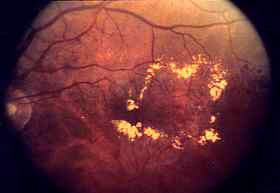Diabetic Retinopathy
Diabetes is a condition that affects all parts of the body. The eye, particularly the retina, is at significant risk for problems.
Retina doctors talk about 3 common ways that diabetes affects the retina:
Background (or Non-Proliferative) Retinopathy
In this condition, the small blood vessels of the retina are damaged from diabetes. Diabetes usually has to have been present at least 5 years for this to occur. Small spots of bleeding and areas of lack of blood supply appear.
This does not usually cause any visual problems. It is important to recognize because it means the other 2 conditions are more likely to occur.
Proliferative Diabetic Retinopathy
In this condition, large numbers of blood vessels in the retina stop carrying blood properly. The retina becomes deprived of enough oxygen and sends signals (hormones) to the retina to create new blood vessels. Unfortunately, the eye loses the ability to create proper blood vessels early in life and only makes weak vessels that tend to BLEED and SCAR. This can cause severe and abrupt visual loss.
Macular Swelling

The blood vessels in the center part of the retina are very susceptible to damage from diabetes. They ooze fluid and cholesterol into the central retina and cause it to become swollen. This swelling makes objects and images appear WASHED OUT or FUZZY.
IF YOU HAVE DIABETES, IT IS VERY IMPORTANT TO SEE YOUR EYE DOCTOR REGULARLY. EARLY DIAGNOSIS AND TREATMENT OF THESE CONDITIONS OFFERS THE BEST CHANCE OF PRESERVING VISION.
LARGE STUDIES HAVE ALSO SHOWN THAT GOOD BLOOD SUGAR CONTROL WITH A LOW HbA1C REALLY HELPS TO REDUCE THE RISK OF DIABETIC EYE DISEASE.
